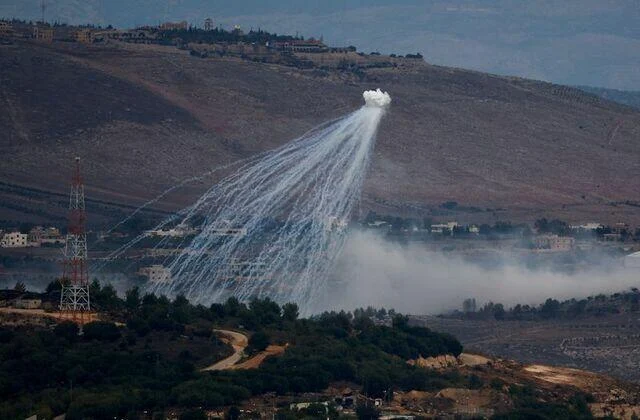The Israeli army used US-manufactured white phosphorous shells in a brutal attack on south Lebanon in October, the Washington Post reported Monday, citing an analysis of shell fragments found in the southern Lebanese village of Al-Dhahira.
A Washington Post journalist came across the remnants of three 155-millimeter artillery shells near the border. Production codes found on the shells indicate that they were made by ammunition depots in Louisiana and Arkansas in 1989 and 1992.
 |
| White phosphorus fired by Israeli army on Nov.12. via Reuters |
Residents told the journalist that the shells in question "incinerated at least four homes." Nine people were injured in the white phosphorous attack, which reportedly took place on October 16, including three who were hospitalized.
Photos and videos verified by Amnesty International show the white phosphorus falling on Al-Dhahira on October 16. "Israeli forces continued to shell the town with white phosphorus munitions for hours," trapping residents in their homes until 7:00 AM the next day, locals told the Washington Post, adding that they now refer to that evening as the "black night."
Israel has used white phosphorous on southern Lebanon over 60 times since the war began in October, according to the Armed Conflict Location & Event Data Project (ACLED). "The Israeli army fired artillery shells containing white phosphorus, an incendiary weapon, in military operations along Lebanon’s southern border between 10 and 16 October 2023," Amnesty International said on October 31st, adding that the October 16 attack must be immediately investigated as a war crime.
Israel claimed its use of the banned munitions was in line with international law, given that they used them to create "smokescreens" and not for targeting, according to an army statement.
However, the October 16 white phosphorous attack took place at night, when "smoke would have little practical use … and [when] there were no Israeli troops on the Lebanese side of the border to mask with smokescreens," Washington Post said.
"Residents speculated
that the phosphorus was meant to displace them from the village and to
clear the way for future Israeli military activity in the area," it
added.
Washington Post confirms that Israel used U.S.-supplied white phosphorus in Lebanon attack https://t.co/8jI1BZAp9w
— jeremy scahill (@jeremyscahill) December 11, 2023
White phosphorous burns at extremely high temperatures and can stick to the skin, posing a potentially lethal threat. Residents of Al-Dhahira reported that remnants of the banned weapon would combust upon contact in the days following the attack. Israel also used white phosphorous in its current war on Gaza, as well as in previous wars in both Gaza and Lebanon.
Crossfire has intensified recently on the Lebanese border. Hezbollah has stepped up its attacks on Israeli military sites and widened its range of targets in response to intense and violent air strikes on southern Lebanese villages and in response to Israeli massacres in the Gaza Strip. Recent Israeli strikes on Lebanon have resulted in several civilian casualties.
По материалам: http://www.planet-today.com/2023/12/us-made-munitions-used-in-israels-white.html